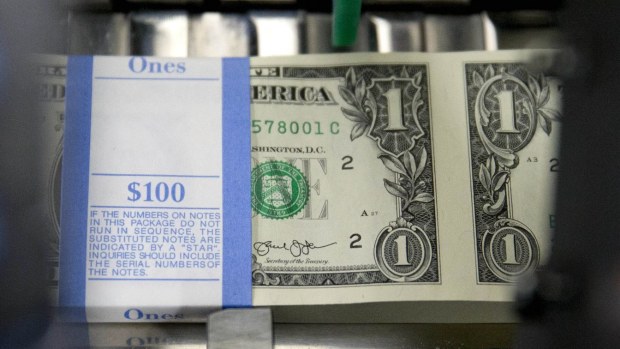$US stumbles as data points to slowing growth
The US dollar dropped for a second day after a larger-than-forecast decline in manufacturing added to signs economic growth is faltering and fuelled speculation the Federal Reserve will push back the timetable for raising interest rates.
The greenback fell against most of its major peers after a report showed American factories are struggling to find more foreign demand amid a 12 per cent surge in the dollar during the past six months. Increases in payrolls and retail sales this month also trailed projections.
"The mix of continued weak US data surprises and the market's love of euro shorts is creating some choppy price action," Matt Derr, a foreign-exchange strategist at Credit Suisse Group AG in New York, said by email. "Euro-dollar will have a tough time moving in either direction in the near-term."

The greenback fell against most of its major peers after a report showed American factories are struggling to find more foreign demand. Bloomberg
The Bloomberg Dollar Spot Index, which tracks the US currency against 10 major peers, fell 0.5 per cent to 1,194.33 at 3.13pm New York time. The US currency fell 0.2 per cent to 119.18 yen.
The euro weakened earlier Wednesday after European Central Bank president Mario Draghi said the €1.1-trillion quantitative easing put in place last month is effective in boosting sagging inflation and reviving the economy. The shared currency fell to $US1.0458 on March 16, its weakest level since January 2003.
"It's going to take, not anything out of the euro zone, but better growth and higher rates in the US to take us to parity," Robert Sinche, a strategist at Amherst Pierpont Securities in Stamford, Connecticut, said in a phone interview. "We've seen the decline in the euro. The next leg will have to be the rise in the dollar."
The dollar has gained 21 per cent during the past 12 months, according to the Bloomberg Correlation-Weighted Index, driven by stronger growth and projections the Fed will raise interest rates this year for the first time since 2006, while central banks around the global add to monetary stimulus.
That divergence in central-bank outlooks has narrowed, while harsh winter conditions slowed economic momentum in the US, causing growth metrics such as retail sales and industrial production to trail estimates. A government report on April 17 is projected to show the rise in consumer prices remains well below the central bank's 2 per cent target.
In contrast, the latest European data signaled deflationary pressures are easing. Consumer prices dropped an annual 0.1 per cent in March, compared with minus 0.3 per cent in February, though that's still the fourth consecutive reading below zero.
"The assumptions at the start of the year were extreme in either direction, that the ECB will do an immense amount of QE and the Fed will raise rates very quickly," Douglas Borthwick, head of foreign exchange at New York brokerage Chapdelaine & Co., said by phone. "Time has passed. Now people think maybe the Fed will take a little longer."
Bloomberg
Subscribe to gift this article
Gift 5 articles to anyone you choose each month when you subscribe.
Subscribe nowAlready a subscriber?
Introducing your Newsfeed
Follow the topics, people and companies that matter to you.
Find out moreRead More
Latest In Currencies
Fetching latest articles